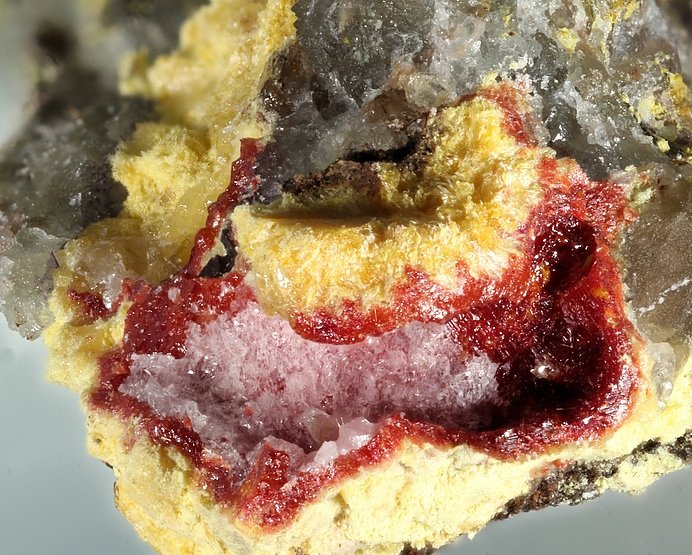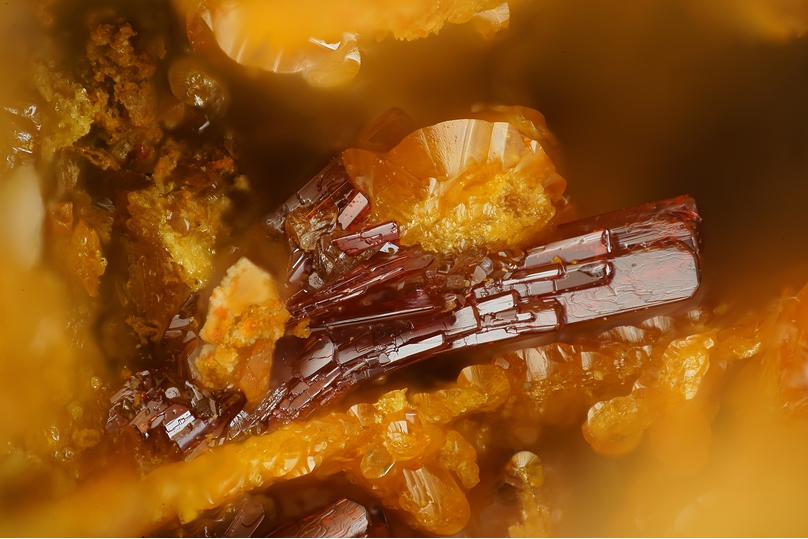Phoenicochroite (original) (raw)
A valid IMA mineral species - grandfathered
About PhoenicochroiteHide
This section is currently hidden. Click the show button to view.
Colour:
Dark red, bright red
Lustre:
Adamantine, Resinous
Crystal System:
Monoclinic
Name:
From the Greek φοίυικος for "deep red" and χρόα for "colour," in allusion to its colour.
This page provides mineralogical data about Phoenicochroite.
Unique IdentifiersHide
This section is currently hidden. Click the show button to view.
Long-form identifier:
mindat:1:1:3194:9
df91e484-1c37-4f64-a8d6-ad9ee888110a
IMA Classification of PhoenicochroiteHide
This section is currently hidden. Click the show button to view.
Approved, 'Grandfathered' (first described prior to 1959)
Type description reference:
Classification of PhoenicochroiteHide
This section is currently hidden. Click the show button to view.
7.FB.05
7 : SULFATES (selenates, tellurates, chromates, molybdates, wolframates)
F : Chromates
B : With additional O,V, S, Cl
35.1.2.1
35 : ANHYDROUS CHROMATES
1 : A2XO4
27.2.6
27 : Sulphites, Chromates, Molybdates and Tungstates
2 : Chromates
Mineral SymbolsHide
This section is currently hidden. Click the show button to view.
As of 2021 there are now IMA–CNMNC approved mineral symbols (abbreviations) for each mineral species, useful for tables and diagrams.
| Symbol | Source | Reference |
|---|---|---|
| Phc | IMA–CNMNC | Warr, L.N. (2021). IMA–CNMNC approved mineral symbols. Mineralogical Magazine, 85(3), 291-320. doi:10.1180/mgm.2021.43 |
Physical Properties of PhoenicochroiteHide
This section is currently hidden. Click the show button to view.
Colour:
Dark red, bright red
Comment:
Turns lemon-yellow on exposure.
Streak:
Brick-red to yellowish orange
Cleavage:
Perfect
Perfect on {201}; poor on {001}, {010}, {011}.
Density:
7.01 g/cm3 (Measured) 7.075 g/cm3 (Calculated)
Optical Data of PhoenicochroiteHide
This section is currently hidden. Click the show button to view.
RI values:
_n_α = 2.340 - 2.380 _n_β = 2.380 - 2.440 _n_γ = 2.650
2V:
Measured: 58° , Calculated: 60°
δ = 0.310
Image shows birefringence interference colour range (at 30µm thickness)
and does not take into account mineral colouration.
Dispersion:
r > v, moderately strong to strong
Optical Extinction:
X = b; Y ∧ c = –2°; Z ∧ c = 88°.
Comments:
Absorption: X < Y < Z.
Chemistry of PhoenicochroiteHide
This section is currently hidden. Click the show button to view.
Mindat Formula:
Pb2(CrO4)O
Crystallography of PhoenicochroiteHide
This section is currently hidden. Click the show button to view.
Crystal System:
Monoclinic
Class (H-M):
2/m - Prismatic
Cell Parameters:
a = 14.001(7) Å, b = 5.675(3) Å, c = 7.137(5) Å
β = 115.22°
Ratio:
a:b:c = 2.467 : 1 : 1.258
Unit Cell V:
513.02 ų (Calculated from Unit Cell)
Morphology:
Crystals tabular and imperfect, often reticularly intergrown. Massive; thin coatings.
Tabular on {100} or {201}, elongated along [010] or [001], showing {010}, {100}, {110}, {201}, {211}, {310}.
Crystal StructureHide
This section is currently hidden. Click the show button to view.
Load
Unit Cell |Unit Cell Packed
2x2x2 |3x3x3 |4x4x4
Show
Big Balls |Small Balls |Just Balls |Spacefill
Polyhedra Off |Si Polyhedra |All Polyhedra
Remove metal-metal sticks
Display Options
Black Background |White Background
Perspective On |Perspective Off
2D |Stereo |Red-Blue |Red-Cyan
View
CIF File Best |x |y |z |a |b |c
Rotation
Stop |Start
Labels
Console Off |On |Grey |Yellow
| ID | Species | Reference | Link | Year | Locality | Pressure (GPa) | Temp (K) |
|---|---|---|---|---|---|---|---|
| 0000204 | Phoenicochroite | Williams S A, McLean W J, Anthony J W (1970) A study of phoenicochroite - its structure and properties American Mineralogist 55 784-792 |  |
1970 | 0 | 293 |
CIF Raw Data - click here to close
X-Ray Powder DiffractionHide
This section is currently hidden. Click the show button to view.
Powder Diffraction Data:
| d-spacing | Intensity |
|---|---|
| 3.39 Å | (100) |
| 2.989 Å | (100) |
| 3.60 Å | (70) |
| 6.40 Å | (40) |
| 3.26 Å | (40) |
| 4.42 Å | (30) |
| 2.840 Å | (30) |
Geological EnvironmentHide
This section is currently hidden. Click the show button to view.
Type Occurrence of PhoenicochroiteHide
This section is currently hidden. Click the show button to view.
Associated Minerals at Type Locality:
Reference:
Glocker E F (1839) 19. Phönikechroit. in Grundrib der Mineralogie, mit Einschlub der Geognosie und Petrefactenkunde, Schrag (Nurnberg) 612-612
Synonyms of PhoenicochroiteHide
This section is currently hidden. Click the show button to view.
Other Language Names for PhoenicochroiteHide
This section is currently hidden. Click the show button to view.
Varieties of PhoenicochroiteHide
This section is currently hidden. Click the show button to view.
| Berezovite | Discredited - shown to be altered phoenicochroite by S.A. Williams (1974). |
|---|
Common AssociatesHide
This section is currently hidden. Click the show button to view.
Associated Minerals Based on Photo Data:
Related Minerals - Strunz-mindat GroupingHide
This section is currently hidden. Click the show button to view.
Other InformationHide
This section is currently hidden. Click the show button to view.
Notes:
Soluble in HCl with separation of lead chloride.
Health Risks:
Chromate minerals contain the carcinogenic and mutagenic chromate ion. Always wash hands after handling. Avoid inhaling dust when handling or breaking. Never lick or ingest. Do not pour chromate-containing solutions down the drain.
Internet Links for PhoenicochroiteHide
This section is currently hidden. Click the show button to view.
References for PhoenicochroiteHide
This section is currently hidden. Click the show button to view.
Reference List:
Localities for PhoenicochroiteHide
This section is currently hidden. Click the show button to view.
This map shows a selection of localities that have latitude and longitude coordinates recorded. Click on the  symbol to view information about a locality. The
symbol to view information about a locality. The  symbol next to localities in the list can be used to jump to that position on the map.
symbol next to localities in the list can be used to jump to that position on the map.
Locality ListHide
This section is currently hidden. Click the show button to view.
 - This locality has map coordinates listed.
- This locality has map coordinates listed.  - This locality has estimated coordinates. ⓘ - Click for references and further information on this occurrence. ? - Indicates mineral may be doubtful at this locality.
- This locality has estimated coordinates. ⓘ - Click for references and further information on this occurrence. ? - Indicates mineral may be doubtful at this locality.  - Good crystals or important locality for species.
- Good crystals or important locality for species.  - World class for species or very significant. (TL) - Type Locality for a valid mineral species. (FRL) - First Recorded Locality for everything else (eg varieties).
- World class for species or very significant. (TL) - Type Locality for a valid mineral species. (FRL) - First Recorded Locality for everything else (eg varieties). Struck out - Mineral was erroneously reported from this locality. Faded * - Never found at this locality but inferred to have existed at some point in the past (e.g. from pseudomorphs).
All localities listed without proper references should be considered as questionable.

